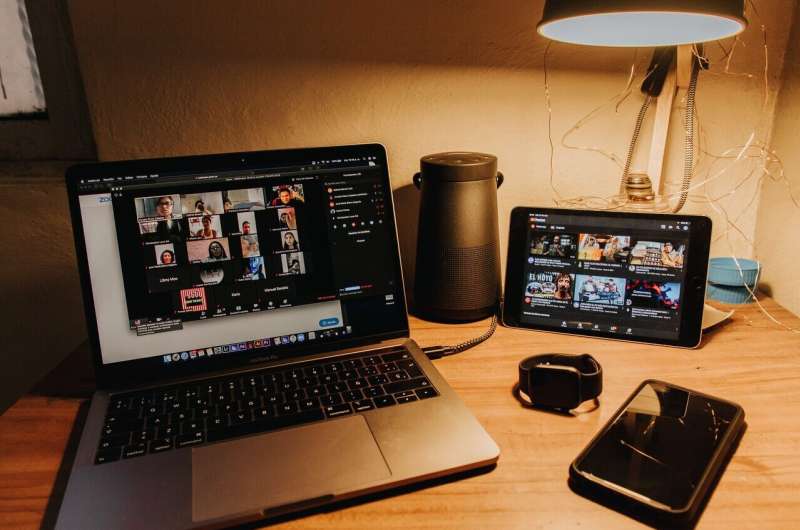Credit: Unsplash/CC0 Public Domain
During the COVID-19 pandemic, online communication increased considerably. Apps, such as Skype, Zoom, FaceTime, and Cisco Webex were key in keeping the educational, economic, and health sectors alive and ongoing during the pandemic.
"Prolonged time facing screens, tablets, and smart devices increases stress and anxiety," said lead author of the study Nour Mheidly. "Mental health stressors resulting from extensive online communication can add to other stressors related to quarantine time and lockdown to eventually lead to exhaustion and burnout."
The study, published in Frontiers in Public Health, explores how the COVID-19 pandemic affected communication and education. In addition, practical steps that help relieve the mental health effects of prolonged online activity were offered.
The study summarizes how prolonged use of smartphones can lead to more depressive symptoms, anxiety and sleep disturbances among females, extroverted personalities, adolescents. In addition, physical health can be affected, as observing screens and hunching over smartphones for extended periods of time can lead to neck pain. "Specifically, bending the neck when using digital screens and smartphones may progressively lead to stresses on the cervical spine; a condition that is commonly known as 'iHunch,'" said senior author of the study Jawad Fares, MD, Northwestern University. "It may also strain the ligaments, muscles, and tendons of the vertebral column," Mohamad Y. Fares, a co-author of the study added.
During the COVID-19 outbreak, imposed lockdowns and compulsory quarantines increased levels of tension. "The inability to socialize, attend gatherings and interact with others enhanced separation anxiety, boredom, and suicidal thoughts, and as such, these emotions were reported more often," Jawad Fares, MD added.
The authors provide eight recommendations to be adhered to during online sessions to decrease the risk of psychological distress and preserve health and wellbeing:
- Promoting awareness on stress and burnout resulting from increased use of telecommunication during pandemics through broadcasting media channels and social media platforms.
- Increasing the frequency of breaks between online lectures or during teleconferences to allow participants to release eye strain and to prevent loss of interest and attention.
- Directing wellness campaigns at students to increase their awareness on the physical and emotional consequences of increased online time.
- Introducing podcast-based communication and learning as a substitute to online visual encounters to decrease eye strain and limit screen exposure.
- Implementing healthy practices in between online sessions and during extended meetings, such as breathing exercises, meditation, and yoga.
- Providing online participants with the opportunity to share their feelings and mental struggles so that proper help and support can be administered.
- Cutting down on unhealthy habits that further increase stress levels, such as smoking and caffeine intake.
- Conducting wide cross-sectional surveys to extrapolate the actual levels of stress and burnout among different online populations.
More information: Mheidly et al., Coping with stress and burnout associated with telecommunication and online learning. Frontiers in Public Health (2020). DOI: 10.3389/fpubh.2020.574969
Provided by Northwestern University
























